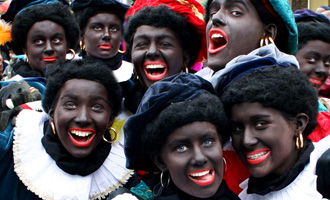Just like two years ago, the UK asked 100 students and employees from different faculties for their opinion on Black Pete. Back then, 52 percent were still in favour of maintaining Sinterklaas’ pal in the traditional form. Now, less than one-third of those surveyed support it, and 37 percent is against Black Pete. The rest has no opinion.
When the numbers are broken down by nationality, it turns out that a small majority of Dutch students and employees are for a ‘black’ Black Pete, and a small majority of internationals are against it.
Opponents feel that a ‘black’ Black Pete is offensive and racist. International students and employees who are against it are more likely to deem the ‘Petes’ racist than Dutch people who oppose it. One international student called Black Pete ‘racially insensitive’. Another said it is not his place to judge Dutch traditions.
Tradition
Those in favour say that it is a celebration for children and a tradition. One person wrote: ‘Children never talk about the comparison between Black Pete and people of colour.’ Other people said they did not care what Black Pete looked like, as long as the annual discussion would just end.
A clear majority of both opponents and proponents do think it is time that Black Pete undergoes a change. They want him to become less stereotypical and be depicted as a different colour or with a soot-streaked face.
Some of those questioned also said that their opinion of Black Pete has changed over the years. A lot of people say that because of the commotion, they have begun to see the dark side of the Black Pete issue. ‘Before, I didn’t realise how offensive it was to some people’, one person said. Another, whose mind has not changed, said: ‘All this nagging has really ruined the festivities for me.’
Decide for themselves
The university has no official policy for what the Black Petes at the various Sinterklaas celebrations across the faculties should look like, says spokesperson Riepko Buikema. ‘The faculties and staff associations can decide for themselves what they want the festival to look like.’
Most of those surveyed agreed with this position and did not think the university should implement a general policy. A few individuals do think such a policy is a good idea since the university should be unified in its approach. Some people posited that the RUG should not discriminate and ought to ensure that the festivities are enjoyable for everyone.
Of two minds
At the Faculty of Economics and Business, they have not come to a consensus yet. ‘In light of the discussion, our Sinterklaas is not overly fond of Black Pete’, says co-organiser Aafke Wiekens. But the company that rents out the clothing and does the make-up only supplies ‘black’ black petes. ‘It’s a difficult position we’re in. We’re of two minds, sort of. We have not found a definitive solution just yet.’
At UMCG, the Black Petes that visit the patients will remain black. ‘We don’t yet know what we’ll do for the children’, says the UMCG’s Käthy de Wit. She also says the discussion is not as prevalent in the hospital.
Two years ago, the UK also held a survey about Black Pete. See those results here.




